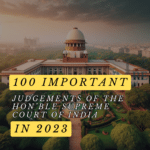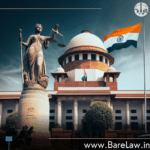Authored By – Dev Gupta

Entering into the 75th Year of the Hon’ble Supreme Court of India
Established in 1950, The Supreme Court of India is entering into the 75th year of its existence. On a cosmic scale, or even an international one, 75 Years seems like an infant stage, since, countries like USA and UK have all had supreme Courts for multiple centuries. Yet The Supreme Court of India has a history of housing some of the most notable judges, passing stentorian judgments and all the while, being a target of – and more often than not – even dodging the politics. Such is the rich history of our Hon’ble Supreme Court which in just a baby span of 75 Years has been witness to a history filled with eloquence, powerful dissents and some of the most depressing times of the Country.
HISTORY:
During the British Colonial Era, after a confusing and ever-changing phase of the legal system, the final appeal method was that the appeals from the High Courts would be decided by the Privy Council in England. In 1937, under the provisions of the Government of India Act, 1935, a federal court was established which would hear appeals from the High Courts. In-spite of this, the Privy Council was the final arbiter in all the matters. The Federal Court ceased to exist on 28th January 1950, with the establishment of the Supreme Court after the Indian Constitution was framed and India was officially a Republic.
SOME NOTABLE JUDGES:
Throughout its span of 75 Years, the courtrooms of The Hon’ble Supreme Court of India have been presided over by a total of 240 Judges, 49 of have had the privilege of being on the forefront of the Judiciary of India as the Chief Justice. All of the Judges, in one way or another, have been party to something that can be said to be worthy of going down in history books, passed some landmark judgments, some names stand out not only in the hearts of the Indian legal professionals, but also internationally.
JUSTICE H. R. KHANNA:
A man of great calibre, Justice H. R. Khanna has become a household name in the legal profession, most famously due to his singular dissent in the ADM Jabalpur aka the Emergency Case. He was the only judge to stand his ground in saying that the constitutional remedy provided by Articles 32 and 226 in the Constitution do not become invalid during an Emergency. He was, as a result, denied the promotion to the position of Chief Justice of India for this dissent. He promptly resigned due to the part politics played in this.
JUSTICE V. R. KRISHNA IYER:
When talking about the history of judges in India, one cannot dare to miss the name of V. R. Krishna Iyer. A judge who was, at his time, known to be at a level of grace and dignity as that of Lord Denning, Justice Iyer till today remain an inspiration to many aspirants of the legal field. Judges may face jail time, impeachment, etc. after their term but this was a judge who had served jail-time before becoming a judge for the fervent activism on his part to support his poor and underprivileged clients. He was a sort of pioneer for the legal aid movement in the country and had voiced his regard for the same via many judgments and activities as an activist. As was with Justice Khanna, Justice Iyer also put the rights and laws conferred by the constitution over political mal-play. He was the one who heard the appeal from the Allahabad High Court’s order of stating P. M. Indira Gandhis win to be unlawful and had refused an unconditional stay on the order. The day after which, perhaps, the darkest period of Indian history began with the Emergency. Another peculiar fact about Justice Iyer was his use of poetry, literature in his judgments.
THE FATHER SON DUO:
Justice Y. V. Chandrachud, since the establishment of the Supreme Court of India has been the longest serving Chief Justice i.e. about for 7 years 5 months. Justice Chandrachud, during his term not only as a chief justice but also as a judge had presided over some of the most important cases of the country such as the Shah Bano Case and as mentioned above the Emergency Case.
His son, the current 50th Chief Justice of India, Dr. D. Y. Chandrachud has also, in recent time been the longest serving Chief Justice of India for a term which began in November 2022 till November 2024. Dr. Chandrachud has presided over cases dealing with the validity of the Abrogation Article 370. He has been at the forefront in shedding light at the importance of having live streaming of Courts throughout the Country.
MR. PALKHIVALA:
Although there is no such thing called as a “Supreme Court Advocate” in the sense that an advocate can only practice in the supreme court (unless designated senior after which an advocate shall only practice in high courts and the supreme court) there have been some throughout history that have cemented their place as some of the best. Ram Jethmalani, Kapil Sibal, Harish Salve are some names that are quite particularly celebrity-like. The one which stands apart from all of them is that of Nani Palkhivala. As some judges are bound to be mentioned when talking about the Indian Judiciary, Mr. Palkhivala is an advocate among the names that cannot be missed when talking about the legal profession. He was the standing counsel in the Kesavananda Bharti case which put forth the basic structure doctrine.
Eloquence, soft convincing nature were some of the qualities he was most famous for. He has been the only advocate to have been appointed Ambassador to the United States.
CASES:
In the 74 years of its existence, the Supreme Court has decided cases which have shaped the destinies of the country and men alike. To mention all of them would make this writing of an elephantine length. Due to that, here are some of them:
- Kesavananda Bharti vs State of Kerala – Doctrine of Basic structure case.
- Mohd. Ahmed Khan vs Shah Bano – Triple Talaq case.
- M. C. Mehta vs Union of India – The Oleum Gas Leak Case
- Indian Medical Association vs V. P. Shantha – Doctors liable in Consumer Protection.
- Common Cause vs Union of India – Euthanasia and Right to Die with Dignity Case.
CONCLUSION:
From the above it is clear that the prestigious legal field in India has gone through many personalities, changes, assents, dissents which have resulted in India being a notable legal figure throughout the world. But in recent time, due to inefficiency of administration and quality of the legal field degrading, The Supreme Court of India has now reached a paramount of 70, 000 pending cases. Being the Apex Court of a country, that is a number much higher than it should be. It is clear that the old ways need to be changed and some new methods have to be adopted in order to restore the efficient and capable image the Supreme Court of India once had.





